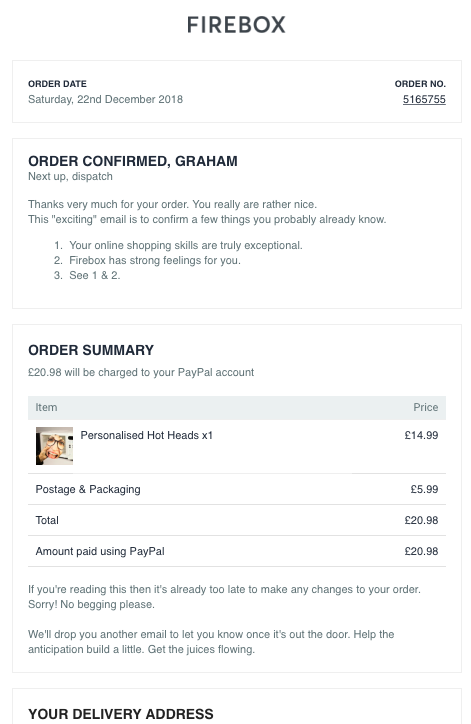Retailers invest huge amounts of money and effort to attract visitors to their website, so that once they’re there, they can convert them into paying customers. A key challenge for these brands is how to maintain contact with website visitors after they’ve made a purchase in order to increase levels of customer service and retention.
We look at how customer retention emails can help to create and drive a customer loyalty cycle and increase repeat purchases, therefore increasing customer lifetime value.
What Are Customer Retention Emails?
To begin your customer retention strategy, it’s important to understand all aspects of the ecommerce customer journey. Customer retention emails are campaigns (or ‘flows’) that are sent to an existing customer once you have established a brand relationship. This customer may have bought something previously, browsed and added to their baskets, or simply just visited your site – either way, customer retention emails can then be sent to remind that customer of their visit. This can overall increase customer satisfaction thanks to the levels of customer service this method creates.
Customer retention emails can be formatted in a number of different ways and be sent at different times depending on your business’s brand presence and marketing strategy. As long as you keep that vital communication alive via retention emails, both old and new customers are likely to stay in your customer base.
Why Use Customer Retention Emails?
Ecommerce business and marketing research has shown that it takes up to five times as much money to acquire a new customer as it does to retain an existing one. However, many marketers, for some understandable reasons, tend to focus on acquisition over retention.
A survey by Econsultancy found that 40% of marketers were more focused on acquisition than retention, with 15% saying the reverse, and 45% having an equal focus.
It’s clear that a good balance of focus on retention can pay off in the longer term, and customer retention emails have a part to play in this, assuming the right foundations are in place.
A strong customer retention email strategy can:
- Reinforce the positive customer experience from the initial purchase.
- Keepyour brand in the customer’s mind to keep the communication channel open.
- Offer opportunities to learn more about customers.
- Drive repeat purchases and cross-selling potential.
The ultimate goal is to build a stronger relationship with customers and fully understand how to increase customer lifetime value.


7 Customer Retention Email Examples
To get to grips with post-purchase emails for better retention, here are examples of seven types of email you can send to customers after they’ve experienced your brand online.
These examples can work for every ecommerce business, and are designed to maintain contact and provide prompts for customers to make repeat purchases.
1. Order Confirmation Emails
Emails confirming a recent purchase have a role to play in confirming the details of the purchase. This include:
- Order contents
- Total cost
- Delivery date and address
- Links to information about returns
- Customer service contact details


These emails can be quite functional – stating the basic facts and leaving it at that. This does the job of reassuring the customer that their order has been placed correctly, but it represents a missed opportunity to impress customers and add more value.
Stats underline the opportunity that transactional emails present. A recent Silverpop study found that transactional emails are opened more than twice as often as ‘standard’ emails (44.9% compared with 20.8%).


Transactional emails can help to reinforce the brand, carrying the branding through from website to email. The right brand tone of voice can also help the relationship to continue on the right footing, making them feel positive about the purchase they’ve just made.
These emails can also be useful beyond presenting the key facts of the transaction, as in this email from Booking.com. It confirms the transaction, but also adds a link for directions to the hotel, a useful City guide to Avignon, and a link to rent a car. All potentially useful for the recipient.
It’s also an opportunity for some smart cross-selling based on the customer’s order and on-site behaviour.


2. Product Recommendations
Emails with product recommendations and consumer reviews are a great way to increase lifetime value. These emails work best when they are personalised, and a customer’s previous purchase history and on-site behaviour is used to improve the relevance of recommendations.


3. Satisfaction Surveys
Surveys can provide some valuable feedback for brands all whilst involving, or retaining, the customer – enabling them to assess levels of customer satisfaction and identify any problems that customers may have had. They also provide some very useful social proof to be used by brands on-site and in their marketing.
In addition, the fact that brands are asking for customer feedback on their experience sends a signal that their custom is valued and the brand is actively looking to provide a great service.
It’s important to ensure that surveys aren’t too much work for customers so you can attract a good amount of responses from them. Remember to balance the amount of information you want with the chances of customers completing the form.


4. Ask for Product Reviews
Emails can be used to ask for reviews of items purchased, which can then be used on product pages and around the website, and even in other forms of marketing, online and offline.
Reviews are a great sales driver, so it pays to gather product feedback from your customers.
These emails also offer another opportunity to keep in touch with customers, similar ecommerce newsletters which attract engagement. And when combined with an incentive like that offered by Schuh below, they can also drive repeat purchases.


5. Replenishment Reminders
This is an issue Amazon addresses with its dash buttons – wi-fi devices which reorder essential products at the push of a button.
Amazon has saved payment details from millions of customers, which allow the retail behemoth to invest in a product like this. For most other retailers, replenishment emails can provide the answer.
Using customer purchase history, retailers can send a timely reminder to customers when they are likely to need replacements for products. They can help to drive revenue while offering a useful service to customers.


6. Sales Notifications
During the Christmas and Black Friday ecommerce shopping periods, people will be receiving plenty of sales notifications in their inboxes. Sales and special offers are a key reason why people sign up to emails from retailers, and they provide a way to tempt existing customers back to the website.
The frequency of sales emails needs to be considered carefully though, as they can become so commonplace that they lose their impact.
For example, Gap sends emails with offers every day or two, to the point where a customer may be unlikely to buy without looking for a discount code.


Other brands use them more sparingly, meaning they can have more impact. For example, this email from Apple raises awareness of their Black Friday sale. Apple sends emails of this nature very rarely, so would make a potential customer take notice.


As with product recommendation emails, using customer data, or customer behaviour, to show relevant offers is likely to produce better results.
7. Birthday or Anniversary Emails
There are other triggers for emails, birthdays being the most obvious example, which allow a brand to keep in touch and reward loyal customers, as in the example below from Ted Baker.
It’s a useful discount for customers, and does show customers that a brand values their custom and loyalty on the most personal level.


In Summary
Good marketing doesn’t end the moment a customer buys from your site. Instead, this should be seen as the beginning of a longer relationship with the customer.
The key theme that runs through all of these emails is that they help to build a long-term relationship with a customer, and therefore increase the lifetime value. It’s about using emails to improve the customer experience by adding value and providing intelligent prompts to drive repeat purchases.
The Experts Guide to
Speak to an expert
Learn how to convert your online audience into revenue with our experts.


Casey Turnbull
Casey is a Fashion Journalism graduate & ecommerce marketing executive at SaleCycle. Casey is committed to producing high quality content backed by in-depth research and data. She has experience developing content in a range of sectors including fashion, ecommerce and sports.








![Valentine’s Day Ecommerce Tips and Trends [2024 Strategy]](https://www.salecycle.com/wp-content/uploads/2019/01/valentines-ecommerce-1.png)




![How SaleCycle helped Vodafone increase their online sales by an additional 2,000 additional sales per month [Extended Version]](https://www.salecycle.com/wp-content/uploads/2023/08/vodafone-banner.webp)




